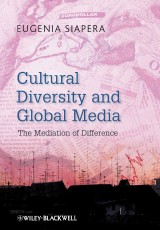Details

Cultural Diversity and Global Media
The Mediation of Difference1. Aufl.
|
36,99 € |
|
| Verlag: | Wiley-Blackwell |
| Format: | |
| Veröffentl.: | 15.01.2010 |
| ISBN/EAN: | 9781444319149 |
| Sprache: | englisch |
| Anzahl Seiten: | 240 |
DRM-geschütztes eBook, Sie benötigen z.B. Adobe Digital Editions und eine Adobe ID zum Lesen.
Beschreibungen
<i>Cultural Diversity and Global Media</i> explores the relationship between the media and multiculturalism. <ul> <li>Summarises and critically discusses current approaches to multiculturalism and the media from a global perspecive</li> <li>Explores both the theoretical debates and empirical findings on multiculturalism and the media</li> <li>Assumes the new perspective of mediation of cultural diversity, which critically combines elements of previous theories in order to gain a better understanding of the relationship between the media and cultural diversity</li> <li>Explores media ‘moments’ of production, representation and consumption, while incorporating arguments on their shifting roles and boundaries</li> <li>Examines separately the role of the internet, which is linked to many changes in patterns of media production, representation and to increased possibilities for diasporic and transnational communication</li> <li>Contains pedagogical features that enable readers to understand and critically engage with the material, and draws upon and reviews an extensive bibliography, providing a useful reference tool.</li> </ul>
<p><b>1 (Re)thinking Cultural Diversity and the Media 1</b></p> <p>1.1 The Crises of Multiculturalism 1</p> <p>1.2 The Mediation of Cultural Diversity 5</p> <p>1.3 The Structure of the Book 8</p> <p><b>2 Theorizing the Nation 14</b></p> <p>2.1 Theories of the Nation 14</p> <p>2.2 A Word on Globalization 25</p> <p>2.3 Conclusions 26</p> <p><b>3 Varieties of Multiculturalism 29</b></p> <p>3.1 A Typology of European Multiculturalism 29</p> <p>3.2 Multiculturalism in Immigration Countries: US and Canada 36</p> <p>3.3 Constitutively Different: India and Nigeria 41</p> <p>3.4 Conclusions 44</p> <p><b>4 Theories of Multiculturalism 46</b></p> <p>4.1 Multicultural Dilemmas 46</p> <p>4.2 Essentialism or Fluidity? 47</p> <p>4.3 Universalism or Particularism? 51</p> <p>4.4 Recognition or Redistribution? 54</p> <p>4.5 Conclusions 58</p> <p><b>5 Media Theories and Cultural Diversity 60</b></p> <p>5.1 Socio-Psychological Approaches to Media 61</p> <p>5.2 Medium Theory 64</p> <p>5.3 Political-Economic Theories of the Media 66</p> <p>5.4 Socio-Cultural Approaches to the Media 70</p> <p>5.5 Mediation: The Difference Media Make 72</p> <p>5.6 Conclusions 75</p> <p><b>6 Media Production and Diversity 78</b></p> <p>6.1 Media Production and Mediation 78</p> <p>6.2 Media Corporations 79</p> <p>6.3 Media Organizations and Media Logics 81</p> <p>6.4 Media Workers 85</p> <p>6.5 Conclusions 92</p> <p><b>7 Minority and Diasporic Media: Controversies and Contributions 94</b></p> <p>7.1 Why Study Minority Media? 94</p> <p>7.2 Issues of Terminology 94</p> <p>7.3 Theorizing the Role(s) of Diasporic Media 97</p> <p>7.4 Diasporic Media: a Typology 102</p> <p>7.5 The Politics of Diasporic Media 106</p> <p>7.6 Conclusions 110</p> <p><b>8 Theories of Representation 111</b></p> <p>8.1 The Work of Representation 111</p> <p>8.2 Stereotyping: the Cognitive Aspects of Representation 112</p> <p>8.3 Framing and Discourse: a First Link to Ideology 116</p> <p>8.4 Semiosis, Discourse, and Representation: an Historical Analysis 120</p> <p>8.5 The Performative Force of Representation 124</p> <p>8.6 Conclusions: Representation and Mediation 127</p> <p><b>9 Regimes of Representation 131</b></p> <p>9.1 The Multiplicity of Representations 131</p> <p>9.2 The Racist Regime of Representation 132</p> <p>9.3 The Domesticated Regime of Representation 139</p> <p>9.4 The Regime of Commodification 143</p> <p>9.5 Conclusions 146</p> <p><b>10 Self-Representations of Cultural Diversity 149</b></p> <p>10.1 Representational Dilemmas 149</p> <p>10.2 The Essentialist Regime of Representation 150</p> <p>10.3 The Alternative Regime of Representation 157</p> <p>10.4 Conclusions 164</p> <p><b>11 Audiences and Cultural Diversity 165</b></p> <p>11.1 What Do People Do with the Media? 165</p> <p>11.2 Audience Reception of Mediated Cultural Diversity 166</p> <p>11.3 Ethno-Cultural Groups as Audiences 170</p> <p>11.4 Media Consumption and Identity 176</p> <p>11.5 Right to Reply: How Can Audiences Respond? 177</p> <p>11.6 Conclusions 182</p> <p><b>12 Cultural Diversity Online 183</b></p> <p>12.1 The Difference the Internet Makes 183</p> <p>12.2 Network Society and Cultural Diversity 184</p> <p>12.3 Mediation of Cultural Diversity Internet Style 187</p> <p>12.4 Conclusions 196</p> <p>Bibliography 198</p> <p>Index 213</p>
"It is easy to read, clearly written and well organised". (Times Higher Education Supplement, 4 November 2010)
<b>Eugenia Siapera</b> is lecturer in Media and Communications at the Aristotle University of Thessaloniki, Greece. She is the author (with Lincoln Dahlberg) of <i>Radical Democracy and the Internet</i> (2007) and (with Joss Hands) <i>At the Interface</i> (2004).
<i>Cultural Diversity and Global Media</i> explores the relationship between the media and multiculturalism. Maintaining that the media actively shapes and constructs understandings of cultural difference, rather than reflecting debates on cultural diversity, Siapera argues that we must look to the media in order to understand cultural diversity and its position in society. <p>Through a thorough analysis of the complexity of the media, Siapera examines the processes of production, representation and consumption of mediated cultural diversity, including the changes in the media landscape introduced by the internet. Moving toward a more holistic understanding of the media and their embeddedness in society, politics and culture, <i>Cultural Diversity and Global Media</i> constitutes an interrogation of mediated cultural difference.</p>
In <i>Cultural Diversity and Global Media</i> we learn that understanding the mediation of cultural diversity requires a comparative, global outlook. This is an invaluable contribution to the study of cultural diversity and media, providing both the tools and background necessary to study media representations of cultural diversity critically. It will help students and faculty alike to understand how discourse and media engage cultural diversity within increasingly complex global contexts. <i>Kent Ono, University of Illinois at Urbana-Champaign</i>


















